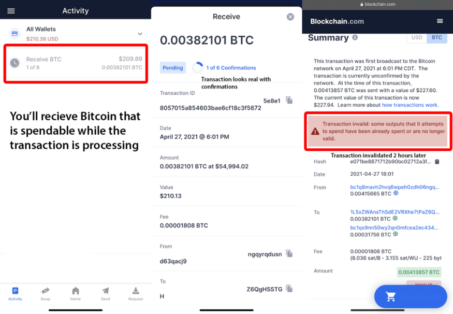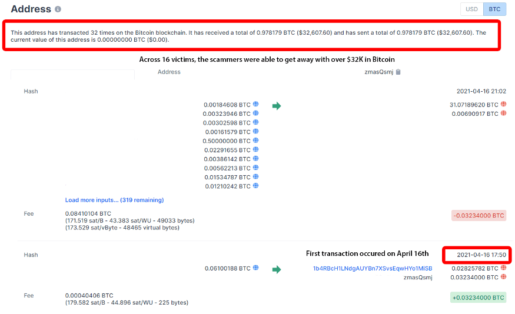



This article was originally published by Matthew Esparza
with special thanks to Kayla Kilbride
The hot new fad among scammers isn’t the classic “buy a gift card and send me the code” or “wire me money via Western Union.” It’s using cryptocurrency to scam innocent victims out of their money. Leveraging people’s ignorance of cryptocurrency and the desire to make money as fast as possible, scammers disguise themselves as credible sources stealing the identity of financial influencers. Scammers then use tactics to lure a victim into sending them money. These scammers are actually making upwards of 6 figures a year deploying these tactics. “US consumers reported $52.6 million in losses from crypto scams to the Federal Trade Commission (FTC) in the first quarter of this year.”

What is Cryptocurrency? Cryptocurrency is a digital asset that allows users to easily buy and sell goods online, treated as a digital currency of the internet. There are many variants of crypto, each with its own unique traits: Bitcoin (BTC) and Ethereum (ETH) being the 2 major powerhouses of the Cryptocurrency market. However, each asset is extremely volatile allowing “investors” to invest in the currency for a potential profit, making it extremely attractive to retail investors. Another key feature of crypto is fast transfers and anonymous payments, allowing scammers to easily make off with victims’ cryptocurrency, leaving them unable to get it back. To the uneducated, many see cryptocurrency as a tool for getting rich. Making it perfect for scammers to use against their victims.
Scammers have to build rapport with a victim to have the best chances of stealing their money. They look to platforms such as Twitter, Instagram, and Facebook to interact with individuals using the identity of Influencers in the finance niche.

These influencers already showcase an exceptional amount of credibility and knowledge in the market with their following alone. So they attempt to recreate the influencers’ account using the same picture, tweets, and sometimes going as far as buying fake followers to make the accounts look real as possible.
Why does this work? People tend to get caught up at the moment when their favorite “influencer” or someone really famous follows them. They tend to ignore subtle details such as engagement or verifying they are the actual “influencer”, making them more susceptible to falling victim to these scams!
There are two very popular methods scammers use to get money from victims. Both are very subtle methods that appear credible for the scammer, however, they use seamless tactics to obtain crypto from the victims.
First, the scammer will approach the victim via DM, appearing to use the identity of the influencer they choose. Starting with small talk such as asking “how their investments are going” or asking about the victim in an attempt to build rapport. After building rapport, they mention they have been working on a project such as a trading method or investment opportunity.
At this point they could divert into 2 different methods:

Scammers have evolved into utilizing the internet to create realistic online platforms, typically built with complex-looking systems, to seem as credible as possible. These platforms attempt to recreate other crypto trading platforms. Scammers will mention this platform, asking victims to set it up, so they can help them with their trading and make a deposit.
However, if the victim makes a deposit they will learn the money does not go to the trading platform. It’s gone forever.

Scammers have been utilizing fake trading platforms to switch out deposit addresses with their own static crypto addresses. So when someone makes a deposit, it goes directly into the scammer’s wallet to never be seen again.
They tend to get people as the site looks professionally built at first, but as victims dig into the website, there is nothing useable except for a chart and fancy buttons that do nothing. There is not even a backend to the website except for a database that stores victims’ login information to use in future operations for the scammers.
This case is very interesting because a scammer sends victims money first! Yes, you read that right, they send money and a lot of it. This is a new take on the common scam known as “cash flipping”. However, scammers use crypto as the catalyst for this scam, particularly bitcoin.

How this works: A scammer will approach a victim’s messages with a fake account to look credible. The victim might be following a version of the account the scammer is impersonating. Usually on another platform but the psychology behind it follows the same guidelines laid out previously.
After building rapport with a victim, they’ll mention a new investment tip that will help them make a lot of money. Now, scammers have gotten smarter, they use credible brands such as Blockchain.com to pull off these scams. Blockchain is a cryptocurrency wallet and exchange that allows people to buy, sell, and trade various cryptocurrencies.
After a victim creates an account on these platforms, the scammer will send the victim a large amount of Bitcoin that naturally appears in their wallet. In the victim’s mind, they suddenly got money from this “influencer”.
The scam continues as they attempt to get the victim to send money back to the scammer, or “send back” the original amount back if uninterested. This is where most people get caught in the scam. Victims either send the original amount back or send more. The mindset typically behind this is: “It must work because you just received money from them, and you can’t lose additional money you just received if you send them the money they gave you.” As soon as the victim sends any amount of money they have been scammed.

Crypto scammers are now utilizing a bug/exploit in Bitcoin’s infrastructure: The Double Spend. Double spending allows a scammer to send the same bitcoin to multiple wallets. However, the first transaction confirmed gets cemented onto the blockchain. That is the wallet where the bitcoin officially goes into. Scammers send victims bitcoin with low mining fees while sending the money to another wallet they own with a higher mining fee. This allows the second transaction to get confirmed first causing the original transaction to be canceled.
If a victim managed to send any money to the scammer, they risk their Blockchain account going negative, as the original transaction is canceled out via double spend, leaving the victim stuck with the bill. Most of these platforms use a KYC (Know Your Customer) model when users sign up, requiring verification of the user via driver’s license or social security number with a selfie to verify it is you. These negative balances can lead to debt and possibly a report to the credit bureau if the victim decides not to pay back the negative balance to the platform.
We get curious about the profitability of these scams and why these scammers are going through the troubles of doing it. With the same mentality as sales and marketing, running this scam is a numbers game.
If a scammer messages X amount of people, there is a probability that one of these people will fall victim to these scams. I managed to dig into the scams previously stated and the numbers are surprising.

With the bait and switch scam that I mentioned above, the scammers were able to steal over $32K in Bitcoin from over 16 victims. With the first victim occurring on April 16th, 2021. After getting the money from the victim, the scammers will funnel the money through multiple wallets to make it appear untraceable.
With the other cryptocurrencies such as ETH, the scammers were able to steal over $2.2K in a matter of two weeks.
At the pace of $34.2 K per quarter, the scammer is on track to make $136.8k a year, (not guaranteed obviously).

Now after checking the Double Spend receiving wallet of the scammer, I was surprised to see the results. The scammer managed to steal over $70.8k from 373 people, averaging about $189.98 per victim. The original scam on this wallet occurred ~6 months before the interaction, suggesting the scammer is on track to make over $141.6k a year from this scam (if able to keep the same pace.)
That’s more money than the average American household makes in a year. However, it’s highly illegal and immoral. It leaves the victims out of money, possibly in debt with a trading platform or worse.
These scams start by luring you in with a sense of trust. Always check who you’re talking to online. Chances that a famous person messaged you personally are very slim, especially if that want to give you an inside tip or ask about your finances.
Here are questions to ask yourself if someone’s messages you:
If any of these questions set off red flags, don’t continue the conversation. Close the messages and report the account.
If something sounds too good to be true such as:
It most likely is a scam, and you should avoid it at all costs. Cryptocurrency is one of the few currencies where transactions are irreversible. Once you send it out, it’s gone forever. Be cautious when people message you about cryptocurrency or your finances. Not everyone is out for your best interests, there are a lot of malicious people in this world.
Impersonating influencers has become a common scam on platforms such as Facebook, Twitter, and Instagram. As long as people are well-educated and look out for red flags, you should be safe from these scammers. However, scammers are getting smarter by the day, I recommend being cautious when you’re interacting with someone new asking about your finances.
I would like to thank my good friend, Kayla Kilbride, for allowing me to use her as an example to showcase what her impersonators were up to. These photos provided were two real-world examples of her impersonators attempting to scam people.

She allowed me to interact with these scammers to gain intelligence on their intentions with potential victims. The reason why they chose to impersonate her is likely due to her platform as an influencer on TikTok and Twitter, giving her credibility to people who are aware of her branding.
If you haven’t already, I would highly recommend checking out both of her platforms as they’re educational for people looking to learn more about the Stock Market & Investing.
Her Twitter is @robinhoodkid and her TikTok is @girlstalkstocks. She’s doing amazing things online and offline! Thank you again Kayla!

Just a Software Engineer that works in the Data Marketing Sector. I invest a lot and my topics include Politics, Finance, and Economics.
Share This Article
Join 10,000+ forward thinkers! Get crypto education in your inbox.